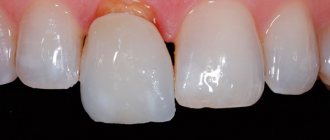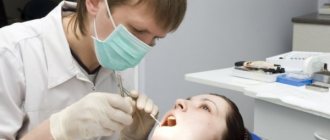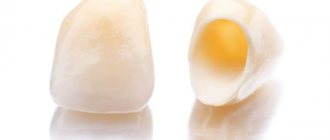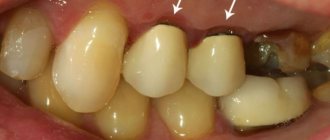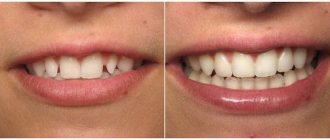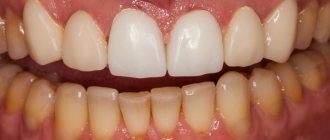4050
Bleeding gums are a common symptom of inflammatory dental diseases.
But when this symptom appears from under the installed prosthesis, the person does not always make the right decision, and instead of visiting the dentist, he begins to use questionable recipes, heat with salt or apply a heating pad, thereby provoking an exacerbation of the inflammatory process.
The cause of this symptom can only be determined by a doctor after a visual examination and a series of diagnostic measures.
Causes
The appearance of bloody discharge from under an installed crown can be a symptom of dental diseases, or occur as a result of a medical error after prosthetics.
In addition, the clinical picture with the appearance of this sign can be formed due to pathological processes in the internal organs.
Dental pathologies that cause a taste of blood in the mouth:
- Gingivitis. Basically, the disease manifests itself as a consequence of insufficient oral care. In this case, additional symptoms of bad breath, pain and loosening of the teeth occur.
- Periodontitis. The disease develops if gingivitis therapy has not been carried out in full. In this case, the symptoms of pain, purulent and bloody discharge become pronounced.
- Stomatitis. Most often, fungal pathogens play the main role in pathogenesis. Its development is accompanied not only by bleeding under the prosthesis. The oral mucosa begins to become covered with erosions and ulcers with a burning sensation and pain.
Medical errors that cause bloody discharge from under orthopedic structures.
| Number in order | Cause | Short description |
| 1 | Large gap between the structure and the dental unit | The entry of food particles along with saliva into the gap causes fermentation. Subsequently, it develops into a process of inflammation. |
| 2 | Traumatization by the sharp edge of the prosthesis | The crown part is installed out of size (has an elevation in relation to adjacent incisors or molars). Under the influence of load, the sharp edge will constantly injure the gum, compromising its integrity. |
| 3 | Unprepared dental canal | Before installing an orthopedic product, a pulp devitalization procedure must be performed. If such manipulation was not carried out, or was performed incorrectly, then the chance of developing bacterial inflammation increases significantly. |
| 4 | Depressurization of the structure | In this case, an infection gets under the prosthesis. This situation occurs due to improper installation of the orthopedic product, or due to the use of low-quality materials. |
| 5 | Installation of an orthopedic product on a tooth to be removed | An attempt to save a tooth by putting a crown on it in most cases cannot stop the decay of bone tissue. The putrefactive process will accelerate destruction with the manifestation of negative symptoms. |
Also, bleeding from under the orthopedic structure can occur in the following situations:
- in advanced forms of diabetes mellitus;
- when diseases affecting blood clotting occur;
- with a deficiency of vitamins and microelements in the diet;
- in case of hormonal imbalance due to disruption of the endocrine system;
- response to the use of certain medications.
The reasons for the appearance of a noticeable gap between the crown and the gum and ways to eliminate the defect.
Visit here to learn more about dental sockets.
At this address https://www.vash-dentist.ru/protezirovanie/nesemnyie-p/koronki-np/restavratsii-keramokompozitnyih.html you will find all the most important things about ceramic composite crowns.
When to see a dentist
When installing a crown, it is recommended not to overload the jaw with chewing hard food during the first weeks. It is better to temporarily switch to broths, soups and purees, and give up apples and seeds. For a speedy recovery, it is necessary to thoroughly rinse your mouth with special antiseptics and treat with ointment with an antimicrobial effect. If you follow all the rules, after 7–14 days a person completely forgets about the bridges that were installed.
Some patients experience complications and problems. This is mainly due to improper installation and assembly of the bridge. An error can occur at any stage. Sometimes a deviation of 1 mm from the size is enough for the product to begin to rub the mucous membrane. A characteristic sign is that the gums around the crown turn red and bleed, and the patient feels full. When biting, the tooth seems to interfere and prevents the jaw from closing completely.
Another common problem is inaccurate fitting of the bridge over ground molars. Sometimes there is a gap that cannot be seen with the naked eye. Microparticles of food get into it and plaque accumulates. This is an ideal place for bacteria to grow, so you should immediately contact your dentist if:
- a person notices an unpleasant odor or taste in the mouth even after brushing;
- when pressing on the crown, ichor or cloudy exudate appears;
- the mucous membrane aches, reacts to changes in temperature and bothers you when chewing;
- The gums under the crown hurt and bleed.
If the doctor was able to preserve the roots and pulp of the tooth, it can easily become infected and acute suppuration develops. The pain becomes very strong and shooting, increasing in the evening or after eating hot food. Purulent fluid quickly accumulates and an inflamed focus forms in the periodontal tissues. It needs a way out, so a lump appears on the gum filled with whitish contents - a fistula. In addition to the symptoms listed above, a person has:
- high fever, weakness and slight chills;
- enlarged lymph nodes under the lower jaw or behind the ears;
- the cheek may become swollen.
This is interesting: Proper care of dental implants after installation
In each case, the help of a specialist is necessary. If you self-medicate, you can seriously delay it until it becomes an acute abscess. Pus easily penetrates inside and spreads throughout the patient’s body, leading to life-threatening sepsis, kidney or liver damage.
Additional symptoms
After installation of an orthopedic structure, sometimes a slight swelling and pain occurs, and ichor may come out from under the prosthesis - this is the norm.
But if these manifestations do not go away within three days, this is a deviation from the norm, and a visit to the dentist cannot be avoided.
Bloody discharge after the installation of orthopedic structures is part of the clinical picture of most problematic situations in dentistry, and therefore occurs simultaneously with other signs.
Most often, their appearance is associated with the development of the following symptoms:
- Painful sensations. Permanent injury to the gums when the rules of prosthetics are violated is accompanied by pain (especially when eating). A feeling of discomfort in the form of throbbing pain becomes a consequence of acute inflammation with the possible formation of an abscess.
- Smell of rotting from the mouth . It can occur both due to insufficient hygienic care and due to the formation of a carious cavity under the dental crown.
- Swelling and hyperemia of the soft tissues of the oral cavity. The patient may perceive the hypertrophied gingival surface as a foreign body.
- Deterioration of general condition. Symptoms of intoxication are accompanied by the appearance of anorexia (partial or complete loss of appetite), an increase in body temperature, and a sharp loss of strength.
Other symptoms
Due to these reasons, in addition to blood, a person may be bothered by other symptoms:
- discomfort;
- aching or sharp pain (if the tooth has not been depulped), especially when biting;
- swelling of gum tissue;
- redness of the gums;
- putrid smell.
If the listed symptoms are not taken into account and you do not consult a dentist, the following will appear later:
- chills or fever;
- weakness;
- burning;
- gum suppuration.
Important! The manifestation of even one of these signs is a reason to immediately seek medical help.
Diagnostics
To eliminate blood discharge from under the tooth crown, it is necessary to establish the cause of the pathological process. This is due to the fact that a set of therapeutic measures should be aimed at treating the underlying disease (the cause must be treated, not the consequences).
Initially, the dentist conducts an external examination and listens to complaints from the patient.
A visual examination of the oral cavity takes place, paying attention to the following changes:
- the state of the degree of redness of the gingival surface is assessed;
- tissue swelling is checked by pressing dental instruments on the gums (if the result is positive, an imprint appears);
- the appearance of a hole will indicate a fistula;
- the release of purulent contents with bloody ichor will suggest the onset of the inflammatory process.
To make a final diagnosis, the most informative method will be an X-ray examination. With its help, the dentist will assess the condition of the root system. In addition, an x-ray will help exclude the development of any type of compaction (cyst or granuloma).
Diagnostic measures
To accurately determine the cause of this phenomenon, you need to consult a doctor. Along with an external examination of the oral cavity, the patient may be prescribed radiography.
Visual inspection
Often, the dentist receives most of the information about the condition of the gums from an external examination.
If damage to the pulp, dentin and enamel coating does not change the condition of the gum tissue, then pathologies of the root membrane will immediately change its appearance:
- The reddened, thickened edge of the gum, the presence of hardened dental plaque indicate gingivitis. Swelling can be easily identified if you press the edge of the instrument onto the gum tissue. After pressing on them, an imprint is formed, which will remain for some time.
- An abscess under the gum is an elongated bulge at the junction of the gum and cheek. Often, severe tissue swelling prevents detection of this formation.
- A fistula is indicated by the presence of a depression with a hole on the gum.
- The discharge of a purulent mass from under the gum margin indicates the presence of chronic gum inflammation.
External examination also reflects the condition of the prosthetic structure. An experienced dentist can determine the degree of wear of the crown, the tightness of its fit to the gum, and the correspondence of the height of the edges in relation to the soft tissues.
Radiography
Allows you to determine the condition of the tooth inside the crown, as well as detect neoplasms and pathological processes in the root.
Treatment
Complex therapy allows you to stop the inflammatory process and get rid of the negative manifestations of the clinical picture.
During treatment, medications and traditional healing recipes are used. Sometimes it becomes necessary to remove the prosthesis and then replace it.
Removing the crown
When bloody discharge is the cause of a medical error due to poor-quality prosthetics, then the development of further inflammation can be prevented only by removing the orthopedic product.
After this, the problem that has arisen is eliminated (the root system, carious cavities are sanitized, or the pathological formation is removed).
After the elimination of negative symptoms, repeated prosthetics are performed. The old structure is not reused, since it is severely deformed when removed.
It should be borne in mind that on the front incisors there is the possibility of retaining the prosthesis. In this case, the canals are cleaned under the crown. In most cases, this technique is used as a temporary measure (when it is not possible to carry out a full restoration complex).
The main factors that provoke an unpleasant odor from under the crown of a tooth and tactics for eliminating the problem.
In this publication we will look at the composition of dental ceramics.
Here https://www.vash-dentist.ru/protezirovanie/nesemnyie-p/oslozhneniy-posle-zubov.html find out what complications may arise after dental prosthetics.
Use of medications
Drug therapy for diseases in the clinical picture of which the main symptom is bleeding from under the crown involves the use of the following medications:
- Antiseptics. They are used for the purpose of rinsing, ridding the oral cavity of the presence of pathogenic microflora. The most commonly used are Furacilin or Hydrogen peroxide, Chlorhexidine or Miramistin.
- Antimicrobial solutions. A positive effect is observed in the case of the use of herbal preparations (Chlorophyllipt, Tantum Verde, Rotocan). It will speed up the regeneration of tissues around the tooth (Cholisal, Metrogyl Denta, Solcoseryl).
- Antibiotics will be the drugs of choice if a bacterial infection is present in the pathogenesis of the disease. Amoxicillin, Doxycycline, Gentamicin or Lincomycin will be effective.
- Antifungal drugs are used to treat candidal stomatitis. Flucostat or Diflucan, Imudon or Mikosist, Pimafucin or Nystatin have positive dynamics.
Traditional medicine recipe
As additional therapy, it is recommended to use pharmacy and homemade infusions and decoctions.
For daily rinsing procedures, it is recommended to use a decoction of chamomile, calendula, sage or oak bark inflorescences. Applications with freshly squeezed aloe juice will help relieve inflammation.
You need to know that any type of medicinal plant is not recommended for use at the initial stage of the disease (without medical prescription). This may mask the clinical picture, causing difficulties in making a diagnosis.
The video provides additional information on the topic of the article.
Folk remedies
In addition to medications, doctors recommend that patients use traditional medicine. You can prepare them yourself or buy them at the pharmacy. As rinses, you can use decoctions of sage, chamomile, calendula, and oak bark. To relieve inflammation, aloe juice can be used to lubricate the gums.
Before making a diagnosis, you should not use any folk remedies. This will blur the picture of the disease and make it difficult to recognize the disease. Treatment can only be started after consultation with a doctor.
Prevention
The erroneous belief that crowns do not require special care leads to the development of pathologies that affect both soft and bone tissues of the oral cavity.
To prevent this, during the process of hygienic care you must adhere to the following rules and recommendations:
- Give up the habit of gnawing hard nuts or crackers.
- Choose the right hygienic paste and brush. Use them to cleanse at least twice a day.
- After each meal, rinse the mouth using rinses or dental elixirs (Acepta, Forest Balm, Lockout Sensitive, Mexidol).
- The spaces between the elements of the dentition are cleaned using a special brush or dental floss.
- A good purchase would be an irrigator, the use of which will remove food particles and provide a gentle massage to the gums.
- To have your teeth professionally cleaned, you need to visit the dental office once a year.
Gingivitis when wearing crowns
The cause of bleeding can be inflammation of the mucous membrane caused by gingivitis. The disease is directly related to the cleanliness of the oral cavity, and therefore often occurs due to poorly fitting dentures. In this case, blood is released when pressing on the crown or appears when brushing with a toothbrush or rinsing with water. The gums become very swollen and take on an unhealthy bluish tint.
Treatment of gingivitis when wearing crowns should be carried out under the supervision of a specialist. At the initial stage, he does not remove them, trying to remove inflammation by rinsing with antiseptics:
- Miramistin;
- Chlorhexidine;
- Furacilin.
Using modern ultrasonic technology, the dentist cleans all spaces and gaps from plaque accumulation, removing possible breeding grounds for bacteria. After this, at home, the patient should rinse his mouth with antimicrobial solutions several times a day. To relieve inflammation, you can use herbal formulations such as Rotocan, Chlorophyllipt or Tantum Verde. After lunch, the gums are irrigated with a weak solution of household soda diluted in warm water.
With gingivitis, the mucous membrane needs special care. Areas near the crowns should be treated with ointments with anti-inflammatory components:
- Holisal;
- Metrogil Denta;
- Dentinox;
- Solcoseryl.
If patients spend time on self-medication using ineffective traditional methods, the gums become very inflamed. When a focus of pus is identified, the crown must be removed to protect the tissue from necrosis. The patient is prescribed a course of antibiotics (Lincomycin or Doxycycline). The oral cavity must be rinsed with antiseptics to stop the spread of infection to healthy teeth. After recovery, you will have to undergo re-prosthetics.
Proper care of installed crowns will help prevent gums from bleeding. A complete hygiene procedure should include not only cleaning each denture with toothpaste. A person needs to walk along the interdental spaces with a special thread - floss. For better plaque removal, you can purchase an irrigator. The miniature device removes all food debris with a stream of water, removing all bacteria that cause infection in the mouth.
Reviews
The majority of the population, faced with such problems, testifies that when a tooth is destroyed under the crown, the prosthesis cannot be preserved.
In addition, sometimes situations arise when a dental unit cannot be treated. You can leave your opinions and comments in this article.
If you find an error, please select a piece of text and press Ctrl+Enter.
Tags dental crowns fixed prosthetics
Did you like the article? stay tuned
Previous article
What to do if your removable dentures are loose?
Next article
How long does it take a patient to get dentures?
Urgent measures
- Eat ice cream/drink chilled water. Cold tends to constrict blood vessels, which will reduce the rate of spread of a possible infection and help stop bleeding. If you apply a gauze swab dipped in cold water to the gum, the result will be the same.
- You can rinse your mouth with a dental rinse and apply a special dental gel to your gums.
- What you need to know! It is not recommended to use solutions based on alcohol and salt: if there is inflammation of the gums, the latter will only worsen the situation.
Possible complications after prosthetics
When installing a crown, the dentist has to carry out a huge amount of preparation, the quality of which determines the patient’s further comfort. It begins with the removal and treatment of carious teeth, the production of perfectly accurate implants and their attachment to the stump. During the first few days a person gets used to the structure, it rubs in and falls into place. Therefore, it is considered quite natural that the gums at the crown bleed and slight swelling appears.
Such problems are quite predictable in the following cases:
- in women during menstruation or with increased progesterone hormone;
- with blood clotting disorders and low potassium;
- with diabetes or high sugar levels.
Therefore, in preparation for prosthetics, experienced dentists include a whole set of tests, examination of the oral cavity, and even allergy tests to dental material. But the best selection does not guarantee 100% survival rate and absence of complications. The most common problems that cause crowns to bleed above or below the gums are:
- The ratio between the size of the prosthesis and the thickness of the mucous membrane was not observed; there was a violation in the process of manufacturing a ceramic veneer or implant. They press and cause swelling, causing the patient to experience discomfort.
- When preparing a tooth or root canal, pathogenic bacteria enter and an infection occurs. In this situation, suppuration of the tissue begins, and the gums rise at the site of accumulation of exudate. When pressure is applied to the crown, a cloudy liquid with a putrid odor emerges.
- A secondary form of caries develops, which leads to damage to the remaining tooth under the bridge. Such a patient has an unpleasant taste in the mouth, reminiscent of sourness.
In any case, the help of a dentist is necessary. Many patients try to eliminate inflammation on their own, so as not to remove expensive prostheses and avoid re-implantation. This leads to the development of sepsis, death of gum tissue or painful fistulas.

